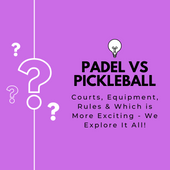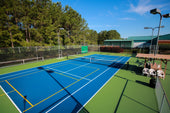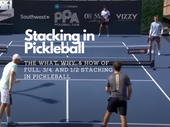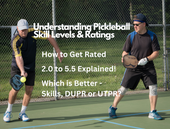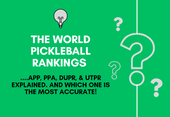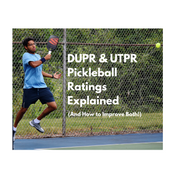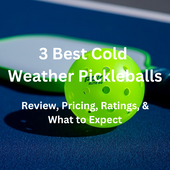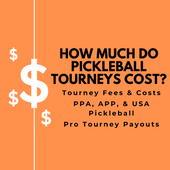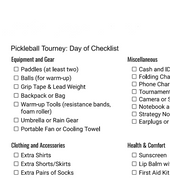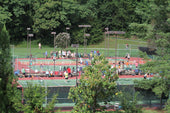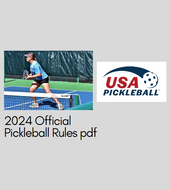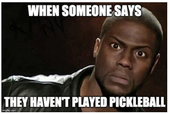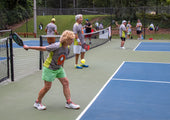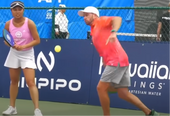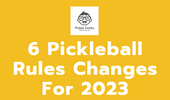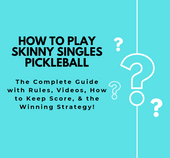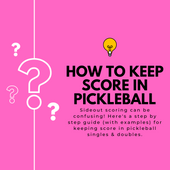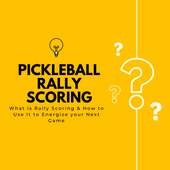If you’ve played pickleball singles, you know it is an entirely different game than doubles.
Singles is faster-paced, has more movement and requires different shot execution than its doubles counterpart.
Added bonus - it’s an unbelievable cardio workout!
Some people call singles pickleball “mini-tennis”, but singles pickleball isn't merely a scaled-down version of tennis. It's a unique sport where you need finesse, power, fitness and an array of shots.
The 2 sports are similar in one way though - strategy plays a key role in success or failure on the court.
Whether you are a newcomer or a veteran of tournament and rec. play, use the 6 pickleball singles strategies highlighted below and take your singles game to the next level.
The 6 Singles Pickleball Strategies to Level Up Your Game
Singles Pickleball Strategy #1 - Don't be a Hero!
It may sound like a cliche to tell someone not to miss a shot (duh!), but in all racket sports more points are lost - with misses or faults - than won (with winners).
This is even true at the highest levels of tennis and pickleball.

Misses and faults are inevitable, but the number 1 thing you can do to improve in pickleball singles is get more balls back over the net and give your opponent the chance to make a mistake.
To miss less, focus on 1) shot selection and 2) not trying to hit the perfect shot.
Shot selection has many different flavors in singles. Singles pickleball is fast-paced and lends itself to smashes, drives, and power shots.
But the best players know when the percentages are in their favor to drive the ball, and when it makes sense to dink or roll a ball to the kitchen to set-up the next shot.
For example, drives are good options on shorter, higher shots from your opponent:
Dinks and rolls are best when your opponent hits deep balls or has you on the run.
If you are on the run or playing defense, try to get 1 more ball over the net with a high percentage dink or roll rather than try a hail mary winner that has little chance of going in.
Conversely, when your opponent is on the run and you have a chance to slam or drive the ball, give yourself a wide margin of error by aiming a few feet inside the side or service lines.
You want to continue putting pressure on your opponent without giving the point away!
In this clip watch how both players use dinks and drops to stay in the point while on defense, and harder, deeper (but high percentage shots) while their opponent is on the run:
Your goal in singles is to make your opponent earn every point with a winner (which they won’t be able to do!).
Singles Pickleball Strategy #2: Practice the Shots You’ll Need
Nothing helps your pickleball game like drilling or practicing the shots you’ll use in a game. In doubles, the 3rd shot drop, dink, and volleys are the most important shots you will hit.
In singles, your serve, return of serve, and passing shots are the most important shots you will hit.

If you want to get better - practice these shots.
- Serves can be practiced alone - just set-up a target deep in the court and practice serves with a bucket of balls.
- Returns of serve can be practiced with a partner or ball machine. First and foremost, practice hitting deep returns and crashing the net. Deep shots are harder to handle and take away an opponent’s power and ability to generate angles to hit good passing shots.
- Passing shots need to be hit low over the net - these can be practiced with a ball machine, backboard, or a partner.
Passing shots can be hard low drives or low dinks/drops that allow you to get to the kitchen line.
Both are great tools to have in your singles arsenal! The key with passing shots is not to go for too much - focus on hitting low over the net and not trying to hit an outright winner past your opponent.
Here's a good example of a low, hard passing shot that sets up an easy put-away on the next shot:
Your opponent will not be able to attack low shots and will often pop-up the next shot giving you a better chance at a passing shot.
Pickleball Singles Strategy #3: Get to the Net
Just like pickleball doubles, singles is a game played (and won) at the net.
Getting to the net puts pressure on your opponent - it shrinks the court (visually and physically), speeds up the points, and forces the opponent to hit low or hard shots to win or stay in the point.

When returning serve, your goal should be to hit the return deep down the middle and get to the net as quickly as possible.
When serving, your goal should be to look for an opportunity to get to the net either through a good 3rd or 5th shot dink or a hard passing shot you can rush the net behind.
Singles Pickleball Strategy #4 - Hit Deep Serves and Returns of Serve
This one is pretty simple in theory and tougher to execute in a game - hitting returns of serve and serves deep into your opponent’s court will immediately increase your probability of winning a point.
Deep serves make it hard for your opponent to return the serve and get to the net quickly or at all, giving you an immediate tactical advantage.
Deep returns of serve will make it hard for your opponent to hit a good 3rd shot dink or passing shot, and greatly increase your chance of receiving an easy put-away at the net.

So how do you hit deeper serves and returns of serves?
For both the serve and return of serve - focus on using your legs (with a good knee bend) while hitting your shot and also aiming the ball 3-5 feet over the net.
A good knee bend helps create lift on the ball and gives you more control over your shot, and having a target height will help you focus on where you want the shot to go.
And as with every shot in pickleball, practicing serves and returns of serves separately from using them in games will help you hit both with more confidence and consistency.
Singles Pickleball Strategy #5 - Be Patient and Choose the Right Shot
Singles pickleball is fast-paced and it’s easy to fall into the trap of hitting the ball hard and going for winners on every shot.
But there are times where your opponent hits a deep return or a good low, short ball that is not attackable.
It’s important to recognize when you are out of position and hit a shot that helps you stay in the point or set-up the next shot you will hit.
Notice in this clip how both players are patient rather than trying to hit drives or winners on every shot:
Pickleball Singles Strategy #6 - Hit & Get Ready for the Next Shot
Since there is less dinking and more driving, singles pickleball is very fast-paced. At times it feels like you just made contact with the ball and the opponent has already hit it back to your side of the court.
After hitting the pickleball, immediately get your racket back into ready position (in front of your body and waist high) and move back toward the center of the court.
Watch Tyson Mcguffin's (far court) footwork in this clip - he is constantly moving to get in position for the next shot:
Focusing on this simple technique will help your footwork and court positioning, which will lead to cleaner shots and fewer errors as you are better prepared to hit each shot during a point.
Summary: Pickleball Singles Strategy
Singles pickleball is an intense, fun, and fast-paced sport that is also an incredible workout.
Although singles and doubles both require patience and minimizing errors, the shots, court movement, and in point strategy are entirely different.
For singles success, remember to be patient and make your opponent earn every point, practice the drives, serves, and returns of serve you'll need to be successful, and during the point focus on your footwork and being ready for the next shot that's quickly coming your way!
Singles Pickleball FAQs
Do you get 2 serves in singles pickleball?
No, there is only 1 serve attempt per point in singles pickleball. If the player faults on a serve then it is considered a sideout and the service turn moves to their opponent. On their service turn, a player will continue serving until the opponent wins a sideout.
Pickleball Singles Scoring
Scoring in pickleball singles is almost identical to doubles. The only difference is that in doubles there are 2 service changes (1 for each player on a team) during their service turn. As a result the score is called out in 3 digit increments in doubles (e.g., 1-2-1 means the serve team has 1 point, the return team has 2 points, and the 1st server is serving for the team currently serving).
In singles, the score is simply 2 digits, with the first digit being the current server’s point total for the game and the 2nd number being the returner’s point total. 5-4 means the server has 5 points and the returner has 4 points.





